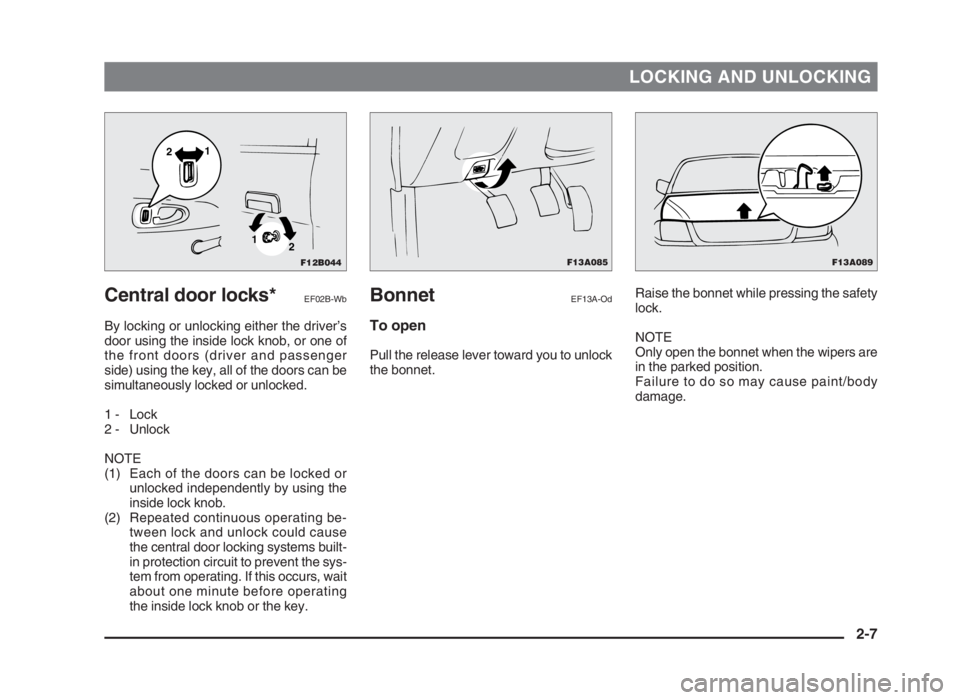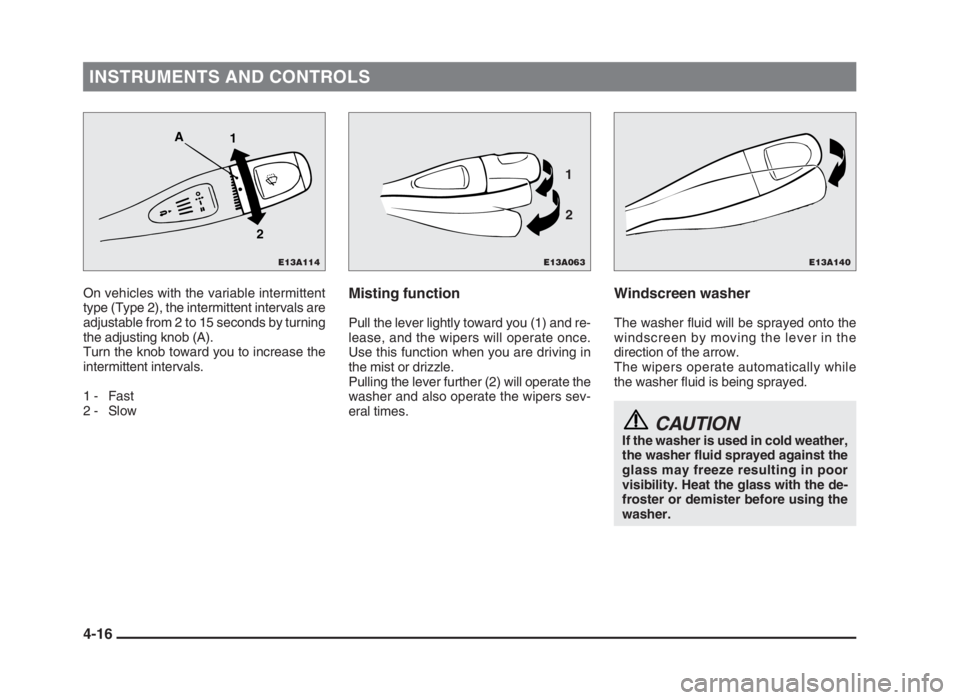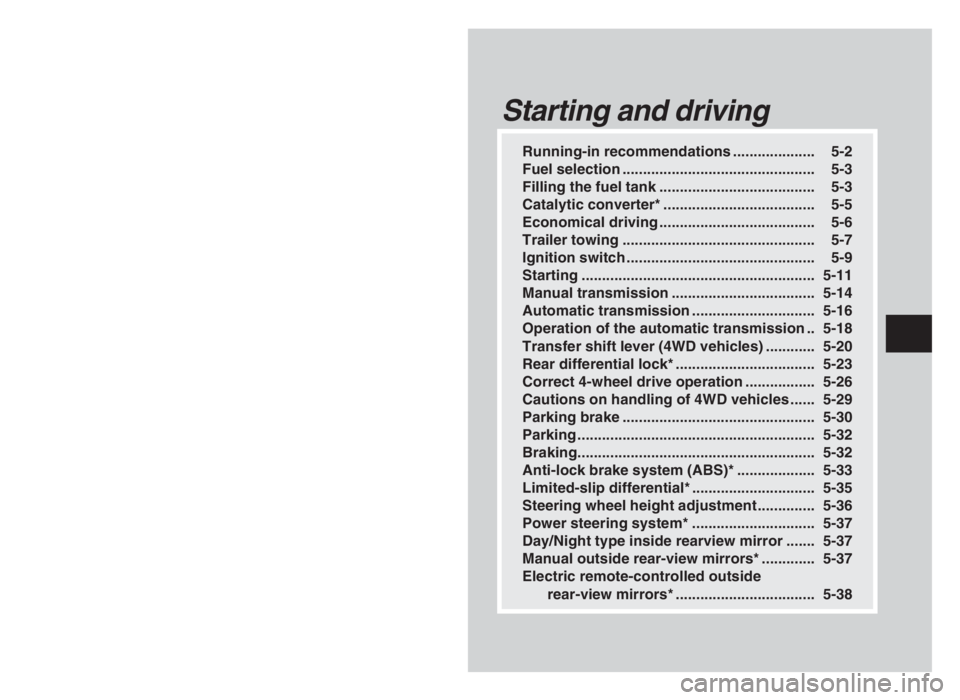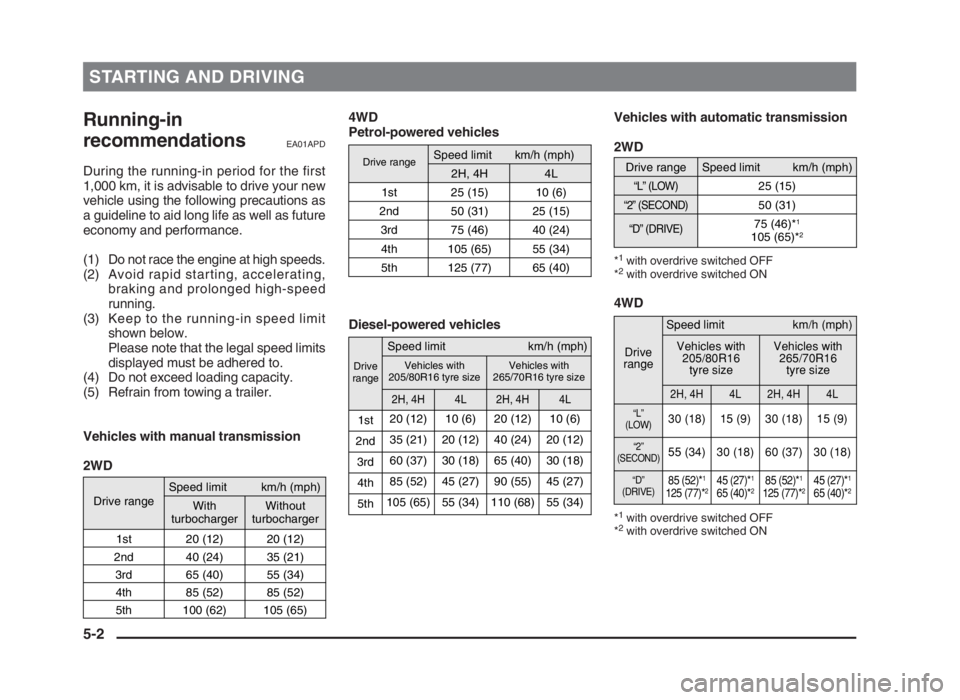tow MITSUBISHI L200 2004 Owner's Manual (in English)
[x] Cancel search | Manufacturer: MITSUBISHI, Model Year: 2004, Model line: L200, Model: MITSUBISHI L200 2004Pages: 264, PDF Size: 4.14 MB
Page 22 of 264

LOCKING AND UNLOCKING
DoorsEF12AAEd
Operation from outside the vehicle
1 - Insert or remove the key
2 - Lock
3 - Unlock
Operation from inside the vehicle
Lock knob
4 - Lock
5 - Unlock
Pull the inside door handle toward you to
open the door.
To lock the front doors without
a key
Set the inside lock knob (1) to the locked
position (so that the red mark cannot be
seen) and, while pulling the outside han-
dle up (2), close the door (3).
“Forgotten-key-prevention” mechanism
(Vehicles with keyless entry system)
If the lock knob on the driver’s door is in
the locked position and the driver’s door is
closed with the key still inserted in the igni-
tion switch, the lock will be automatically
released.
2-4
F12A102
1
2
3
F12A100
1
3 2
F12A101
54
02engL2_240082_4 22-01-2004 12:59 Page 2-4
Page 23 of 264

LOCKING AND UNLOCKING
To lock the rear doors (Double cab)
Set the inside lock knob (1) to the locked
position (so that the red mark cannot be
seen), and close the door (2).
CAUTION(1) Make sure the doors are closed:
driving with doors incompletely
closed is very dangerous.
(2) Never leave children in the
vehicle unattended.
(3) Be careful not to lock the doors
while the key is inside the
vehicle.
NOTE
(1) The keyless entry system does not
operate if the key is left in the key
cylinder, or any door is open.
(2) If the UNLOCK switch is pressed and
no door is opened within approxi-
mately 30 seconds: relocking will
automatically occur.
(3) The remote control switch will operate
within about 4m from the vehicle.
However, the operating range of the
remote control switch may change if
the vehicle is located near a TV trans-
mitting tower, power station, or radio
broadcasting station.
(4) If the doors cannot be locked or un-
locked after pressing the remote con-
trol switch, the battery inside the
switch may need to be replaced.
Replace the battery at your autho-
rized MITSUBISHI dealer.
(5) If your remote control switch is lost,
please contact your authorized
MITSUBISHI dealer for a replace-
ment remote control switch.
Keyless entry system*EF11B-Za
Press the remote control switch, and all
doors will be locked or unlocked as
desired.
Operation of all doors
To lock
Press the LOCK switch, and all doors will
be locked. When they are locked with the
room lamp at the [•] position, the room
lamp and the turn-signal lamps blink
twice.
To unlock
Press the UNLOCK switch, and all doors
will be unlocked. When unlocked with the
room lamp at the [•] position, the room
lamp will be turned on for approximately
15 seconds and turn-signal lamps will
blink 4 times.
2-5
F12A103
1
2
F12D030
02engL2_240082_4 22-01-2004 12:59 Page 2-5
Page 25 of 264

LOCKING AND UNLOCKING
Central door locks*EF02B-Wb
By locking or unlocking either the driver’s
door using the inside lock knob, or one of
the front doors (driver and passenger
side) using the key, all of the doors can be
simultaneously locked or unlocked.
1 - Lock
2 - Unlock
NOTE
(1) Each of the doors can be locked or
unlocked independently by using the
inside lock knob.
(2) Repeated continuous operating be-
tween lock and unlock could cause
the central door locking systems built-
in protection circuit to prevent the sys-
tem from operating. If this occurs, wait
about one minute before operating
the inside lock knob or the key.Raise the bonnet while pressing the safety
lock.
NOTE
Only open the bonnet when the wipers are
in the parked position.
Failure to do so may cause paint/body
damage.
BonnetEF13A-Od
To open
Pull the release lever toward you to unlock
the bonnet.
2-7
F13A089F12B044
21
1
2
F13A085
02engL2_240082_4 22-01-2004 12:59 Page 2-7
Page 29 of 264

LOCKING AND UNLOCKING
Safety mechanism
If a hand or head is trapped in a closing
window, the window glass will lower auto-
matically.
Nonetheless, be sure that nobody sticks
their head or hand out the window when
closing a window.
The lowered window will become opera-
tional after a few seconds.
WARNINGThe safety mechanism is cancelled
just before the window is fully
closed. This allows the window to
close completely. Therefore be es-
pecially careful that no fingers are
trapped in the window.
To close
1. Pull the centre of the lever toward
you.
2. When the window is closed, lock the
lever securely.
Quarter window (Club cab)
EF18B-E
To open
1. Pull the lever all the way in the direc-
tion of the arrow.
2. Press the centre of the lever to hold it
securely in place.
2-11
F18B006
1
2
F18B005
1 2
02engL2_240082_4 22-01-2004 12:59 Page 2-11
Page 42 of 264

SEAT AND SEAT BELTS
To fasten
Pull the seat belts out slowly while holding
the plate.
NOTE
When the seat belts cannot be pulled out
in a locked condition, pull the belts once
forcefully and then return them. After that,
pull the belts out slowly once again.
Insert the plate into the buckle until a
“click” is heard.
CAUTION(1)Never wear the lap belt portion of
the across your abdomen. During
accidents it can press sharply
against the abdomen and increase
the risk of injury.
(2) The seat belts must not be
twisted when worn.
Pull the belt slightly to adjust looseness as
desired.
To unfasten
Hold the latch plate and push the button
on the buckle.
NOTE
As the belt retracts automatically, keep the
latch plate held while retracting so that the
belt stows slowly. Failure to do this could
damage the vehicle.
3-10
G28A068G28A067
03engL2_240082_4 22-01-2004 13:01 Page 3-10
Page 75 of 264

INSTRUMENTS AND CONTROLS
4-11 Check engine indication lamp - amber*
ED85AAH
This lamp is a part of an onboard diagnostic sys-
tem which monitors the emissions, engine sys-
tems.
If a problem is detected in one of these systems,
this lamp illuminates. Although your vehicle will
usually be drivable and not need towing, have the
system checked as soon as possible at an autho-
rized MITSUBISHI dealer. This lamp will also illu-
minate for a few seconds when the ignition key is
turned to the “ON” position. If it does not go off af-
ter a few seconds, take the vehicle to an autho-
rized MITSUBISHI dealer.
CAUTION(1) Prolonged driving with this lamp illumi-
nated can cause further damage to the
emission control system. It could also
affect fuel economy and drivability.
(2) If the lamp does not illuminate when
the ignition key is turned to the “ON”
position, have the system checked at
an authorized MITSUBISHI dealer.
CAUTION(3) If the lamp illuminates while the engine
is running, avoid driving at high speeds.
During vehicle operation with the lamp
illuminated, the vehicle may not accel-
erate when you depress the accelerator
pedal. When the vehicle is stationary
with the lamp illuminated you must de-
press the brake pedal more firmly than
usual since the engine idling speed is
higher than usual and the vehicle with
an automatic transmission has a
stronger tendency to creep forward.
NOTE
The engine electronic control module accommo-
dating the onboard diagnostic system has various
fault data (especially about the exhaust emission)
stored.
This data will be erased if a battery cable is dis-
connected, which will make a diagnosis more dif-
ficult. Do not disconnect a battery cable when the
check engine indication lamp is ON.
04engL2_240082_4 22-01-2004 13:20 Page 4-11
Page 80 of 264

INSTRUMENTS AND CONTROLS
4-16
On vehicles with the variable intermittent
type (Type 2), the intermittent intervals are
adjustable from 2 to 15 seconds by turning
the adjusting knob (A).
Turn the knob toward you to increase the
intermittent intervals.
1 - Fast
2 - SlowWindscreen washer
The washer fluid will be sprayed onto the
windscreen by moving the lever in the
direction of the arrow.
The wipers operate automatically while
the washer fluid is being sprayed.
CAUTIONIf the washer is used in cold weather,
the washer fluid sprayed against the
glass may freeze resulting in poor
visibility. Heat the glass with the de-
froster or demister before using the
washer.
Misting function
Pull the lever lightly toward you (1) and re-
lease, and the wipers will operate once.
Use this function when you are driving in
the mist or drizzle.
Pulling the lever further (2) will operate the
washer and also operate the wipers sev-
eral times.
E13A063
1
2
E13A140E13A114
A
2 1
04engL2_240082_4 22-01-2004 13:20 Page 4-16
Page 87 of 264

Running-in recommendations .................... 5-2
Fuel selection ............................................... 5-3
Filling the fuel tank ...................................... 5-3
Catalytic converter* ..................................... 5-5
Economical driving ...................................... 5-6
Trailer towing ............................................... 5-7
Ignition switch .............................................. 5-9
Starting ......................................................... 5-11
Manual transmission ................................... 5-14
Automatic transmission .............................. 5-16
Operation of the automatic transmission .. 5-18
Transfer shift lever (4WD vehicles) ............ 5-20
Rear differential lock* .................................. 5-23
Correct 4-wheel drive operation ................. 5-26
Cautions on handling of 4WD vehicles ...... 5-29
Parking brake ............................................... 5-30
Parking .......................................................... 5-32
Braking.......................................................... 5-32
Anti-lock brake system (ABS)* ................... 5-33
Limited-slip differential* .............................. 5-35
Steering wheel height adjustment .............. 5-36
Power steering system* .............................. 5-37
Day/Night type inside rearview mirror ....... 5-37
Manual outside rear-view mirrors* ............. 5-37
Electric remote-controlled outside
rear-view mirrors* .................................. 5-38
Starting and driving
5
05engL2_240082_4 22-01-2004 13:04 Page 5-1
Page 88 of 264

Vehicles with automatic transmission
2WD
*1with overdrive switched OFF
*2with overdrive switched ON
4WD
*1with overdrive switched OFF
*2with overdrive switched ON
STARTING AND DRIVING
Running-in
recommendations
EA01APD
During the running-in period for the first
1,000 km, it is advisable to drive your new
vehicle using the following precautions as
a guideline to aid long life as well as future
economy and performance.
(1) Do not race the engine at high speeds.
(2) Avoid rapid starting, accelerating,
braking and prolonged high-speed
running.
(3) Keep to the running-in speed limit
shown below.
Please note that the legal speed limits
displayed must be adhered to.
(4) Do not exceed loading capacity.
(5) Refrain from towing a trailer.
Vehicles with manual transmission
2WD4WD
Petrol-powered vehicles
Diesel-powered vehicles
5-2
Drive rangeSpeed limit km/h (mph)
With
turbochargerWithout
turbocharger
1st 20 (12) 20 (12)
2nd 40 (24) 35 (21)
3rd 65 (40) 55 (34)
4th 85 (52) 85 (52)
5th 100 (62) 105 (65)
Drive range
Speed limit km/h (mph)
2H, 4H4L
1st 25 (15) 10 (6)
2nd 50 (31) 25 (15)
3rd 75 (46) 40 (24)
4th 105 (65) 55 (34)
5th 125 (77) 65 (40)
Drive range
Speed limit km/h (mph)
“L” (LOW)
25 (15)
“2” (SECOND)
50 (31)
“D” (DRIVE)
75 (46)*
1
105 (65)*
2
Drive
range
Speed limit km/h (mph)
Vehicles with
205/80R16
tyre sizeVehicles with
265/70R16
tyre size
2H, 4H4L2H, 4H4L
“L”
(LOW)30 (18) 15 (9) 30 (18) 15 (9)
“2”
(SECOND)55 (34) 30 (18) 60 (37) 30 (18)
“D”
(DRIVE)85 (52)*1
125 (77)*245 (27)*1
65 (40)*285 (52)*1
125 (77)*245 (27)*1
65 (40)*2
Drive
range
Speed limit km/h (mph)
Vehicles with
205/80R16 tyre size
Vehicles with
265/70R16 tyre size
2H, 4H4L2H, 4H4L
1st20 (12) 10 (6) 20 (12) 10 (6)
2nd35 (21) 20 (12) 40 (24) 20 (12)
3rd60 (37) 30 (18) 65 (40) 30 (18)
4th85 (52) 45 (27) 90 (55) 45 (27)
5th105 (65) 55 (34) 110 (68) 55 (34)
05engL2_240082_4 22-01-2004 13:04 Page 5-2
Page 93 of 264

STARTING AND DRIVING
5-7
(1)Starting
Avoid rapid acceleration and sudden
starts; such operation will result in
higher fuel consumption.
(2)Shifting
Shift only at an appropriate engine
speed. Always use the highest gear
possible.
The transfer shift lever should be set
to “2H” when driving 4WD vehicles on
normal roads and express ways to
obtain best possible fuel economy.
(3)City traffic
Frequent starting and stopping in-
creases the average fuel consump-
tion. Use roads with smooth traffic
flow whenever possible. When driving
on congested roads, avoid use of a
low gear at high engine speeds.
(4)Idling
The vehicle consumes fuel even dur-
ing idling. Avoid extended idling
whenever possible.
(5)Speed
The higher the vehicle speed, the
more fuel consumed. Avoid driving at
full speed. Even a slight release of the
accelerator pedal will save a signific-
ant amount of fuel.Trailer towingEC21APDd
In order to tow a trailer with your vehicle,
have a trailer towing device that meets all
pertinent regulations in your area mount-
ed at an authorized MITSUBISHI dealer.
The regulations concerning the towing of
a trailer may differ from country to country.
It is recommended that you obey the regu-
lations in each area.
CAUTIONDanger of Accident!
A towing bar should be fitted by an
authorized MITSUBISHI dealer.
NOTE
Fitting of a towing bar requires specialized
skills and equipment.
Contact an authorized MITSUBISHI dealer
for details. If you are going to tow a trailer,
pay careful attention to the following
points.
(6)Tyre inflation pressure
Check the tyre inflation pressures at
regular intervals. Low tyre inflation
pressure increases road resistance
and fuel consumption. In addition, low
tyre pressures adversely affect tyre
wear and driving stability.
(7)Load
Do not drive with unnecessary articles
in the luggage compartment. Espe-
cially during city driving where fre-
quent starting and stopping is ne-
cessary, the increased weight of the
vehicle will greatly affect fuel con-
sumption. Also avoid driving with un-
necessary luggage, etc., on the roof;
the increased air resistance will in-
crease more fuel consumption.
(8)Cold engine starting
Starting of a cold engine consumes
more fuel.
Unnecessary fuel consumption is also
caused by keeping a hot engine run-
ning. After the engine is started, com-
mence driving as soon as possible.
(9)Air conditioning*
The use of the air conditioning will in-
crease the fuel consumption.
05engL2_240082_4 22-01-2004 13:04 Page 5-7